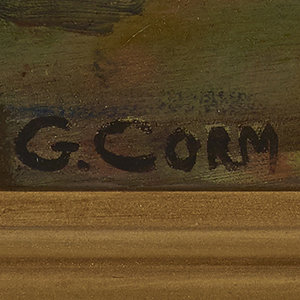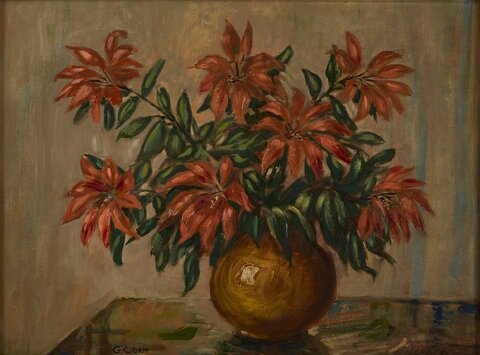Georges Daoud Corm was born in Beirut in 1896 to a family of scholars from Kesrouan. Georges followed in the footsteps of his father, Daoud, a pioneering Lebanese painter, and was thus a...


GEORGES CORM, Lebanon (1896 - 1971)
Bio
Written by NATHALIE BSAT
Georges Daoud Corm was born in Beirut in 1896 to a family of scholars from Kesrouan. Georges followed in the footsteps of his father, Daoud, a pioneering Lebanese painter, and was thus a second-generation artist in two ways: firstly, in a literal sense, as an artist’s son, and secondly insofar as he belonged to the second wave of painters in the country. Alongside artists such as Marie Haddad and César Gemayel, Corm built upon the groundwork laid by his father and others who had introduced easel painting to Lebanon on a large scale. Much like the elder Corm, his style was primarily academic but developed its rhythm because of his additional exposure to less conventional art academies such as Julian and Colarossi. A respected writer and cultural activist, Corm distinguished himself from the older generation of painters with a slightly lighter palette and looser brushstrokes.
Like most first- and second-generation Lebanese artists, Corm went to Paris to complete his education. He studied painting at the Ecole Nationale des Beaux-Arts under the mentorship of well-known portraitist Fernand Cormon from 1919 to 1921, returning to Lebanon during a period of drastic social change. As the Ottoman Empire collapsed and gave way to the French Mandate, the traditional aristocracy that had dominated Lebanon’s small art market was foundering. Fewer aristocrats meant fewer portrait commissions, which were the exclusive purview of the upper class, but it also enabled Lebanese artists to start thinking beyond the classicism that was still in vogue among old patrons. A confusing time for the artists: while traditional styles and subjects of art were, to a certain extent, being called into question, abstraction, and other forms of modernism remained highly unpopular and misunderstood. Artists grappled with the demands of the market, the pressures of their formal training, and the appeal of modernism as it swept the global art scene in various manifestations.
The market for portraits of aristocrats and religious figures flourished under Corm’s father, and despite the changing tides of the art world, the younger Corm attempted to keep the “family tradition” alive. Importantly, however, he deviated from the narrow focus on patron portraits, creating images of peasants and working-class people in the spirit of nineteenth-century French social realists like Gustav Courbet. At this stage, the artist positioned himself politically as a humanist whose beliefs were firmly rooted in the Christian faith, and his aesthetic principles cohered around related ideas. Faced with the proliferation of abstraction in modern painting, Corm rejected the disappearance of lifelike human features from the canvas, adhering instead to a realist aesthetic that celebrated the perfection and beauty of the human body and soul. He expressed his fidelity to such stylistic and thematic choices in his writings, such as in his Essay On the art and civilization of this era, 1966, as well as through his visual art.
His determination to reach the spiritual and moral realms through accurate representation appears in his commissioned portrait as in the artist’s self-portraits. The proliferation of the self-representations in the artist’s production can be seen to document the growing awareness of the social status of the artist in Lebanon at this time or maybe a call to establish such social esteem. Moreover, Corm’s nudes were almost direct and calculated contrast to the perfect portraits of upper-class women. Though he never betrayed his commitment to depicting the world around him, the artist did romanticize that world to a certain extent, rendering landscapes in dense, poetic layers of bright colors. Predominantly, Georges Corm worked in oil on canvas and pastel on paper.
As Lebanon moved towards independence, its rapidly changing society did not foster a comfortable environment for traditional portraitists. Much of the élite that had filled his father’s coffers had left the country, and those who remained, preoccupied with politics, gave little regard to art in general, much less the living or financial conditions of its artists. Though he still earned commissions from the upper echelon of Lebanese society, Corm could not support a family with the amount of money he made as an artist. Seeking a more favorable market for his line of work, he moved to Egypt in 1928, exhibiting in the country’s salons and otherwise remaining active in the Egyptian art scene for the next two decades. In the 1950s, however, his financial situation began to deteriorate. The subsequent period of austerity and depression was felt profoundly in his work, which saw the disappearance of the lavish, abundant still-lifes and refined Lebanese and Egyptian landscapes that had previously occupied a prominent place in his oeuvre. Finally returning to Lebanon in 1956, Georges Corm quickly retreated from the public eye, neglecting his social life as well as his career. During his absence, Beirut had become a haven for modern art, and the artist withered under the assessments of critics who deemed him too old-fashioned for the times. Corm’s health declined rapidly in the mid-1960s, and though a 1966 surgery bought him some time, the struggling artist would never fully recover. He last exhibited his work in 1967, and died four years later, in 1971.
Sources
Corm, Georges D. Essai sur l'art et la civilization de ce temps. Beirut, 1966.
Corm, Georges G. ed. Georges Daoud Corm, Peintre et Portraitiste Libanais, 1893-1971. Beirut, 1981.
Chahine, Richard. One Hundred Years of Plastic Arts in Lebanon, 1880-1980, vols. I&II. (Beirut: Chahine Gallery, 1980), 7.
Fani, Michel. "Corm, Georges," Dictionnaire de la Peinture au Liban (Paris: Editions de L'Escalier), 81-83.
Abillama, Nour Salamé, Marie Tomb, Amin Maalouf, Joseph Tarrab, Cesar Nammour, Maha Azizé Sultan, Fayçal Sultan, and Gregory Buchakjian. Art from Lebanon: modern and contemporary artists, 216-227. Beirut, Lebanon: Wonderful editions, 2012.
Esanu, Octavian. "Lebanese Painterly Humanism: Georges D. Corm (1896-1971)." AUB - Current - Lebanese Painterly Humanism. Accessed December 04, 2017. http://website.aub.edu.lb/art_galleries/current/Pages/humanism.aspx.
Rogers, Sarah. Georges Daoud Corm. Accessed December 04, 2017. http://www.encyclopedia.mathaf.org.qa/en/bios/Pages/Georges-Corm-1.aspx.
CV
Selected Solo Exhibitions
2013
Lebanese Painterly Humanism: Georges D. Corm (1896-1971), American University of Beirut Art Gallery, Lebanon
1981
Retrospective, Chamber of Commerce and Industry, Beirut, Lebanon
1967
Galerie du Journal de L'Orient, Beirut, Lebanon
1964
Phoenicia Hotel, Beirut, Lebanon
1958
Gallery XIV, Beirut, Lebanon
Selected Group Exhibitions
2023
Partisans of the Nude: An Arab Art Genre in an Era of Contest, 1920-1960, Wallach Art Gallery, Columbia University, New York City, United States
2018
Ten Stories from the Sursock Museum Collection, Beirut, Lebanon
2016
The Arab Nude: The Artist as Awakener, AUB Art Gallery, Beirut, Lebanon
2012
Art from Lebanon, Beirut Exhibition Center, Beirut, Lebanon
2009
Landscapes. Cityscapes.1, Maqam Art Gallery, Beirut, Lebanon
Le Corps découvert, Insitut du Monde Arabe, Paris, France
1966
Salon d'Automne, Paris, France
1921
Beirut Exhibition Fair, Lebanon
Awards and Honors
1958
Officer, Lebanese National Order of the Cedar
1955
Honorary Member, Royal Society of Arts, London
1937
Medal of Honor of Lebanese Merit
1936
Officer, Academie de France
1922
Winner, concept for Lebanese Medal of Merit
1921
Gold Medal, Beirut Exhibition Fair
Collections
Sursock Museum, Beirut, Lebanon
Ramzi and Saeda Dalloul Art Foundation, Beirut, Lebanon
Dr. Georges Corm collection, Beirut, Lebanon
Lebanese Ministry of Culture, Collection, Beirut, Lebanon
Mathaf: Arab Museum of Modern Art, Doha, Qatar
Documents
Ten Stories from the Sursock Museum Collection
Sursock Museum
Sursock.museum, English, 2018
Lebanese Painterly Humanism: Georges D. Corm (1896-1971)
AUB, English, 2013
GEORGES CORM Artwork
Become a Member
Join us in our endless discovery of modern and contemporary Arab art
Become a Member
Get updates from DAF
Follow Artists
Save your favourite Artworks
Share your perspectives on Artworks
Be part of our community
It's Free!
We value your privacy
TermsCookiesPrivacy Policies
Become a Member
Get updates from DAF
Follow Artists
Save your favourite Artworks
Share your perspectives on Artworks
Be part of our community
It's Free!
We value your privacy
TermsCookiesPrivacy Policies
Become a Member
Get updates from DAF
Follow Artists
Save your favourite Artworks
Share your perspectives on Artworks
Be part of our community
It's Free!
We value your privacy
TermsCookiesPrivacy Policies
Welcome to the Dalloul Art Foundation
Thank you for joining our community
If you have entered your email to become a member of the Dalloul Art Foundation, please click the button below to confirm your email and agree to our Terms, Cookie & Privacy policies.
We value your privacy, see how
Become a Member
Get updates from DAF
Follow Artists
Save your favourite Artworks
Share your perspectives on Artworks
Be part of our community
It's Free!
We value your privacy
TermsCookiesPrivacy Policies




